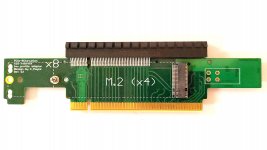I'm not clear what "dual bifurcation" refers to - I've usually seen bifurcation written as a concatenation of the lane breakdowns, so an x16 slot breaking down to 2 or 4 would be listed as "x8x8" or "x4x4x4x4" - similarly, an x8 slot would be "x4x4" - they usually don't bifurcate down further than that, with the exception of laptop vendors doing their M.2 slots as x2x2 to support the Optane H-series cards.
But yes, in a system that only supports x8x8, you'd need to set the host port to x16 and use a PLX chip to get four NVMe devices at x4 each in the slot. Putting a non-PLX card might result in 2/4 cards working, or a very confused host system as it would see two devices physically inserted in each x8 "slot" and probably refuse to even complete the POST.
There's also some slots that break down heterogenously, such as x8x4x4, which lets you insert such wild devices as this one that jams two M.2 2280 NVMe SSDs and a low-profile x8 slot (for an HBA or NIC) into a single PCIe slot, while lining up the top of the LP bracket with the regular-height screw hole.

one PCIe x16 input one PCIe x8 electical / x16 mechanical output (top) two M.2 2280 slots (front/backside) 22110 not possible on this revision PCIe gen3 (for gen4 - special attention to signal quality is required) BIOS support neccesary (Please verify your BIOS has the appropriate options...
c-payne.com
(I have zero affiliation and have never purchased this card - other users here have, and I really admire the engineering.)


